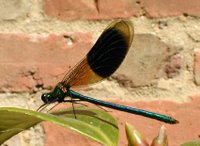 There are two species in the UK - Banded Demoiselle (Calopteryx splendens) and Beautiful Demoiselle (C virgo). Fauna Europaea tells me that France has both of these and 2 more species of Calopteryx, but I have not seen the other two. One of them rejoices under the name C haemorrhoidalis. In French, Banded Demoiselle is calopteryx eclatant (Bright Calopteryx) and the Beautiful is calopteryx vierge (Virgin Calopteryx). Eclatant can also mean 'bursting' - think chocolate eclairs - but perhaps we shouldn't go there - and I've got no idea why the other one is virginal. It seems curious that the English word for the genus is French and the French word is Greek. I suspect there is a more vernacular French name, but I have yet to come across it. In the US, Demoiselles are apparently called Jewelwings.
There are two species in the UK - Banded Demoiselle (Calopteryx splendens) and Beautiful Demoiselle (C virgo). Fauna Europaea tells me that France has both of these and 2 more species of Calopteryx, but I have not seen the other two. One of them rejoices under the name C haemorrhoidalis. In French, Banded Demoiselle is calopteryx eclatant (Bright Calopteryx) and the Beautiful is calopteryx vierge (Virgin Calopteryx). Eclatant can also mean 'bursting' - think chocolate eclairs - but perhaps we shouldn't go there - and I've got no idea why the other one is virginal. It seems curious that the English word for the genus is French and the French word is Greek. I suspect there is a more vernacular French name, but I have yet to come across it. In the US, Demoiselles are apparently called Jewelwings.It is not so common to see the two species together, because they have different habitat requirements. Bandeds like slow moving water, over silt; Beautifuls need fast moving water and gravelly riverbeds - but you can see both on the river at Montrésor. Males can be told apart because Banded Demoiselles' wings are not wholly irridescent navy blue. Usually the tip is clear and the base, with the dark pigment not extending beyond the node (the little dip in the leading edge of the wing). Females are metallic green with golden yellow wings and very difficult to tell apart.
A walk along the riverbank in Montrésor in July is charming. You look across the river into lovely gardens descending right to the water, and beyond them the thoroughly picturesque chateau. If you look the other way, wave after wave of swallows (hirondelles) sweep low over a water meadow like heat seeking missiles, dodging left and right at high speed, hunting flies.
Something, perhaps the swallows, hunts the Demoiselles too. I found several sets of discarded (undigestable) wings on the path - all male Bandeds. Just beyond the water meadow, and having crossed over to the other side of the river, we came across a gathering of Demoiselles - mostly male Bandeds, but with some females and some male Beautifuls. The males, as usual, were fighting amongst themselves, spiralling upwards in twos or threes in choreographed posturing, and the females were lurking about much more discreetly and minding their own business. The fighting males had the perfect sunny platform of yellow waterlilies and floating waterlily leaves to stage their show.
 Demoiselles are a type of large damselfly and are particularly feeble and half hearted looking flyers. They generally wave all four wings about in a rather vague and unco-ordinated way and look as if it is all the most tremendous effort staying airborn, much less moving forward. (All dragonflies can, and frequently do, move all 4 wings independently). Occasionally you will see a Demoiselle making a proper effort and obviously on a mission to get somewhere, but generally you get the impression they just aren't trying (especially if you compare them to the Star Wars spaceship style of the Four-Spotted Chaser or an Emperor Dragonfly chasing an intruder off his pond).
Demoiselles are a type of large damselfly and are particularly feeble and half hearted looking flyers. They generally wave all four wings about in a rather vague and unco-ordinated way and look as if it is all the most tremendous effort staying airborn, much less moving forward. (All dragonflies can, and frequently do, move all 4 wings independently). Occasionally you will see a Demoiselle making a proper effort and obviously on a mission to get somewhere, but generally you get the impression they just aren't trying (especially if you compare them to the Star Wars spaceship style of the Four-Spotted Chaser or an Emperor Dragonfly chasing an intruder off his pond).The male Demoiselle approach to flying is apparently to attract as much attention as possible from females. Like all dragonflies, you see males much more than females, because they are holding territory. The very flappy style means that a male Demoiselle glitters in a hopefully irresitable way. I have been told that some males, in their desperation to impress, will fly upstream, fling themselves upside down on to the surface of the water and float down past the females, presumably waving their little legs seductively all the while. This is an incredibly high risk strategy, as at any moment a fish may spot them, an easy meal, and pluck them off. It is believed that risk element of the behaviour is what is supposed to impress females, who are so bowled over by this reckless courage that they allow mating to occur.
Susan

No comments:
Post a Comment